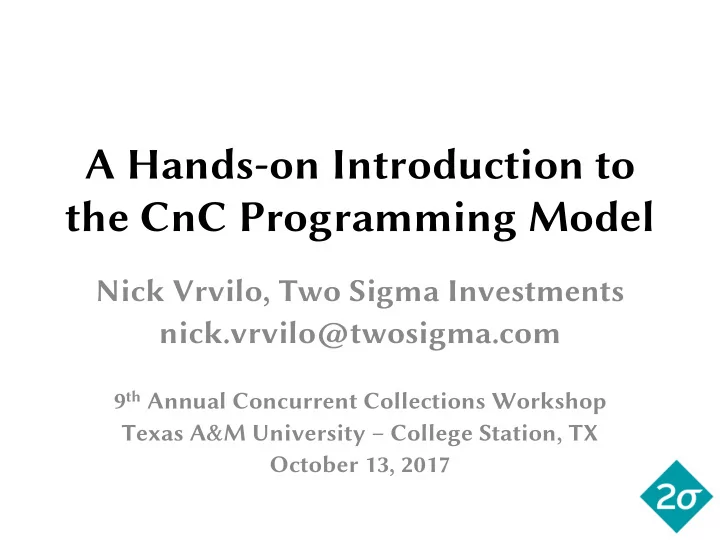

A Hands-on Introduction to the CnC Programming Model Nick Vrvilo, Two Sigma Investments nick.vrvilo@twosigma.com 9 th Annual Concurrent Collections Workshop Texas A&M University – College Station, TX October 13, 2017
The CnC programming model • Programming model (not a language) • Graph coordination – Declare data items and computation steps – Similar computation/data instances grouped into collections • Data items use single assignment – A given item’s value cannot be updated • Step functions written in host language 2
Simple CnC graph sketch “GET” Data A “PRESCRIBE” initializer Step X Step Y “PUT” Data B finalizer 3
CnC input/output relations (“tag functions”) Data A ⟨ x-1 ⟩ Step Y Step X ⟨ x*2 ⟩ ⟨ x ⟩ Data B ⟨ x, 1..10 ⟩ 4
Benefits of the CnC model • Collection relationships are declarative • Exposes implicit parallelism • Program structure follows naturally from the “whiteboard” design process 5
Thanks to Kath Knobe for this LULESH sketch 6
Thanks to Ellen Porter for this LULESH graph 7
CnC-OCR workflow 1. Specify CnC graph • Currently in text form • Ideally provide a graphical tool 2. Run graph translator tool • Parses the textual graph specification • Provides step function skeleton (suggested code) • Generates makefile, scaffolding code 3. Implement step function bodies 4. Compile and run the application 8
Hands-on example 3-point 1D stencil 9
Stencil description • 3-point stencil over a vector of size N • a i,t vector element at index i on timestep t 10
Vector at t =0 1 0 0 0 0 0 0 0 0 0 1 11
Tiling the vector 1 0 0 0 0 0 0 0 0 0 1 1 0 0 0 0 0 0 0 0 0 1 12
Calculating values for t =1 t = 0 1 0 0 0 0 0 0 0 0 0 1 1 0 0 0 0 0 ¼ 1 ¼ 0 0 t = 1 13
Time to code! 1. Install Intel CnC: https://icnc.github.io/ 2. Install the Habanero CnC Framework: https://github.com/habanero-rice/cnc-framework 3. Get CnC Framework dependencies ( just run the translator tool: ucnc_t ) 14
t = 0 1 0 0 0 0 0 0 0 0 0 1 1 1 ¼ 0 0 0 0 0 0 0 ¼ t = 1 15
Recommend
More recommend